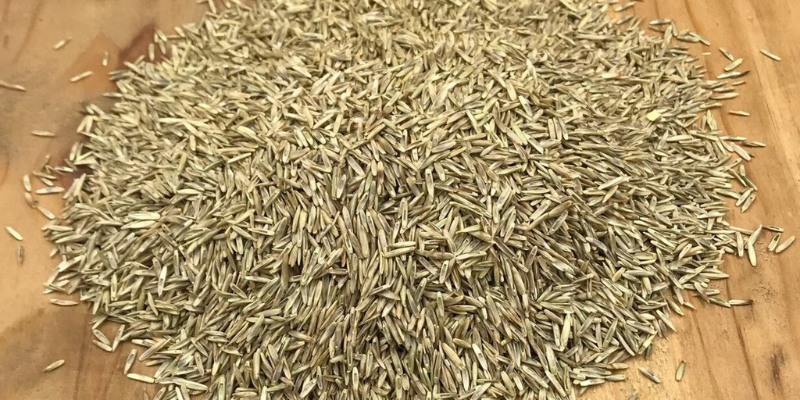How Much Ryegrass Seed Per Acre
Ryegrass seeding rates can vary significantly; understanding these variations is crucial for successful cultivation. Here, we delve deeper into factors influencing how much ryegrass seed you’ll need per acre.
The ryegrass seed typically ranges between 15 to 40 pounds per acre. This broad range is due to various factors like the type of ryegrass, the seeding method, and the intended use of the plantation.
Seeding Rates by Rye Grass Type
- Winter Rye: For winter rye, the target is to have about 1 million live plants per acre. This translates to around 1 bushel (or 56 pounds) of seed per acre, ensuring a dense enough coverage for the colder season.
- Annual Ryegrass: The seeding rate for annual ryegrass is lower than winter rye. For normal seeding, 10 to 15 pounds per acre is recommended. However, the rate increases to 18 to 25 pounds per acre for aerial, broadcast, or dormant seeding.
Solo vs. Mixed Seeding
Ryegrass can either be seeded alone or mixed with other compatible species, each scenario requiring different seeding rates:
- When ryegrass is seeded alone, a rate of 30 to 40 pounds per acre is recommended. However, depending on soil conditions or the intended use, a lower rate of 6 to 10 pounds per acre might be suggested.
- In mixed seeding scenarios, particularly with compatible or adapted legumes like alfalfa, birdsfoot trefoil, and white or red clover, a lower rate of 4 to 8 pounds per acre is advised.
Method of Seeding
The method of seeding holds a pivotal role in determining the amount of ryegrass seed needed:
- If you’re drilling, a rate of 30 pounds per acre is recommended, while broadcasting requires a slightly higher rate of 35 pounds per acre.
Soil Conditions and Intended Use
The condition of your seedbeds and the purpose behind planting ryegrass, whether for forage, cover cropping, or turf, can also dictate the required seeding rate.
It’s advisable to seek guidance from local agricultural extension services to tailor the seeding rate to your local conditions and specific goals.
Consulting Local Experts
Given the variability in recommended seeding rates, consulting with local extension offices or agronomy experts is prudent. They can provide personalized advice based on your area’s soil conditions and the type of ryegrass you intend to plant, ensuring your ryegrass’s successful establishment and growth.
Tips for Seeding Ryegrass in Your Pastures
In the Southern regions, overseeding cool-season annual forage crops such as annual ryegrass and small grains (cereal rye, wheat, oats, and triticale) is a time-honored establishment practice for grazing, baleage, or hay production. Depending on the establishment method and fertilization, these crops offer high-quality forage during late fall, winter, and spring. They can either be established using tillage or by overseeding existing pastures.



However, when overseeding, managing the growth of the warm-season grass component (bermudagrass and bahiagrass) is crucial to ensure it doesn’t impede the germination and establishment of annual ryegrass or small grains.
Below are practical tips to guide you through a successful overseeding process:
Soil Sampling and Preparations
- Begin by taking a representative soil sample to understand your soil’s nutritional status.
- Ensure the perennial warm-season pasture (bahiagrass or bermudagrass) is grazed or clipped short (1–2 inches) to prepare the seedbed.
Seed Bed Preparations
- Lightly disks the soil to increase seed-soil contact.
- Post-seeding, employ a chain harrow or roller to ensure all seeds reach the ground and aren’t trapped in the bermudagrass or bahiagrass stubble.
No-Till Drilling
- A no-till drill is preferred, requiring the pasture to be clipped less than 2 inches.
- In certain cases, chemical sod suppression with a burndown herbicide like paraquat or a light dose of glyphosate can be beneficial. Cool-season annual planting can occur 5–7 days post glyphosate application or 1–3 days post paraquat application. Ensure your no-till drill is calibrated correctly for accurate seed placement.
Seeding Rate
- Plant annual ryegrass seed at 30 pounds per acre if drilling or 35 pounds per acre if broadcasting. Small grains should be seeded at 90–120 pounds per acre. Adjust seeding rates based on whether you are establishing a monoculture or mix.
Fertilization
- Apply phosphorus and potassium based on soil-test recommendations.
- Hold off on applying nitrogen until the ryegrass or small grains have emerged and reached about 2 inches in height. A rule of thumb is to apply one nitrogen unit for every grazing day. Ensure not to mix nitrogen fertilizer with seed as it can damage the embryo and reduce germination and stand establishment.
Grazing Management
- Once established, keep animals off the pasture until the plants reach a grazing height of 8–10 inches, then graze down to about 3 inches of stubble height before rotating the animals to allow recovery.
It’s crucial to graze down your cool-season annual forage crops in late spring to prevent suppression of summer perennial pastures. Increase your stocking rate in spring, when annual ryegrass is at peak production, to avoid moisture and sunlight competition with emerging bermudagrass or bahiagrass.
The outlined tips guide successful overseeding, ensuring a bountiful forage yield across seasons while keeping your pasture vibrant and healthy. So, as you plan your next overseeding, keep these guidelines in hand for a fruitful cultivation cycle.
The ryegrass seeding rate per acre is influenced by multiple factors, each requiring careful consideration to ensure successful cultivation. It’s always advisable to seek professional advice to tailor the seeding rate to your specific circumstances, ensuring a thriving ryegrass crop.

